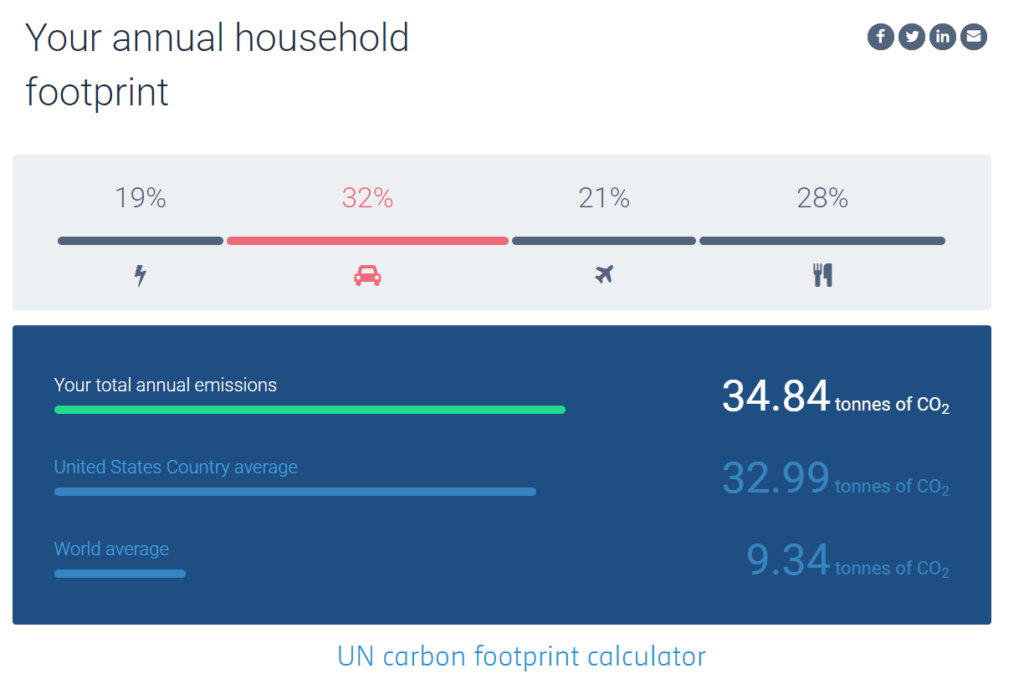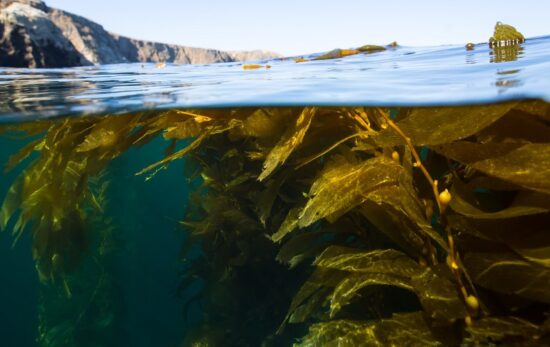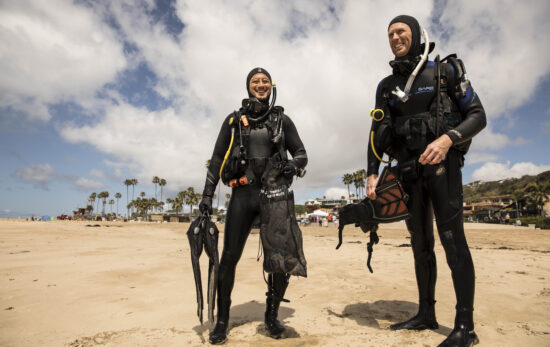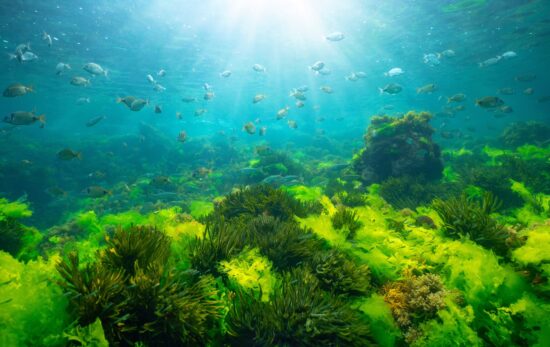On a scale of 1 to 10, how eco-friendly is your lifestyle? If you’re not sure, a quick way to measure your environmental impact is with the United Nations (UN) carbon footprint calculator. It took me less than two minutes to type in my info and get a snapshot of my personal impact.
Here are my results (gulp).

Looks like my annual dive getaway every winter isn’t doing the environment any favors! Good thing PADI Travel® has an optional carbon offset donation that supports Seagrass Grow.
The reality is, there are a lot of factors that go into an eco-friendly lifestyle, and a quick carbon footprint calculator can’t account for everything. Our everyday actions: the food we eat, products we buy (or don’t buy) all make an impact.
How to Live an Eco-Friendly Lifestyle
We know you care a lot about our ocean planet. So you’re probably already doing eco-friendly things like:
- Avoiding single-use plastics
- Recycling as much as possible (and cleaning recyclables thoroughly)
- Buying local, in-season produce
- Having a meatless meal at least once/week
- Making sustainable seafood choices
- Using energy-efficient appliances and lighting
- Choosing products with minimal packaging
- Properly disposing of electronics, paint, batteries and other pollutants
- Buying earth-friendly bath and cleaning products
- Using alternative transportation or driving a fuel-efficient/electric vehicle
Ready to level-up? If you read the list above and thought, “of course I’m doing all of these things,” here are a few ways to up your game:
- Rightcycling – pay close attention to what can’t be recycled. For example, packing peanuts and number 5 plastic aren’t widely accepted. Search online to find places that can accept these items, or find ways to reuse them.
- Refill household cleaning supplies and bath products from a bulk supply store instead of buying a new bottle when you run out
- Avoid taking solo car trips. Use alternative transportation as much as possible
- Compost, use rain barrels and invest in solar panels
- Don’t use chemical fertilizers that can cause toxic algae blooms downstream
- Encourage friends and family to live an eco-friendly life by giving eco-friendly gifts, collecting their hard-to-recycle items, etc.
Go Above and Beyond – A truly eco-friendly lifestyle means making the smallest impact possible. This can mean doing things that are the opposite of how many of us grew up, and maybe feel uncomfortable at first. A sustainable life means you can’t have fresh berries in winter or always wear the latest styles. But over a lifetime, small sacrifices make a huge difference in the health of our planet.
- Only eat food produced locally and sustainably
- Use only natural products like vinegar and lemon juice to clean
- Never use chemicals in your garden
- Create a habitat for bees, bats, or butterflies
- Minimize your use of heat and air conditioning
- Keep your clothes for many years (repairing when necessary)
- Avoid meat and animal products entirely
Feeling overwhelmed? Don’t be. Every adventure starts small, and saving our ocean planet is no different.
Join the PADI®Torchbearer movement.
Living a more eco-friendly life is easier than you may realize. Check out some of the ideas and resources below. Choose a few things to work on and know that any effort you make – makes a difference.
Minimize Energy Use
- Dry your clothes on a rack instead of in the dryer – your clothes will last longer too.
- Open windows instead of using air conditioning – at home or in the car.
- Keep your refrigerator and freezer full – empty air requires more energy to keep cool.
Put on a sweater and slippers instead of turning up the heat – how cute are these?

Eat Local and In-Season
When you see out-of-season fruits or vegetables at the store, they’ve likely racked up a lot of frequent flyer miles to get there. That’s why it’s better to only buy in-season produce. It tastes better and you support local farmers.
Drive Less, Don’t Let Your Car Idle
As a diver, you already know the physical and mental health benefits of being outdoors. If you currently drive everywhere, think of ways you substitute your legs for your wheels.
- Try an alternate form of transportation one day a week – take note of how you feel on the days you’re not stuck in traffic (probably a lot better).
- Instead of making multiple stops, can you park one place and walk to multiple destinations?
- If bicycling or walking isn’t your thing, learn to roller skate or skateboard, or try an electric scooter.
If driving a personal vehicle is your only option, always turn off the engine when parked. Don’t let it idle. Idling vehicles create 30 million tons of carbon dioxide emissions each year. That’s the equivalent of nearly 10 coal-fired power plants.
Automotive experts and the Environmental Defense Fund recommend drivers follow the 10-second rule: turn off your car if you plan to idle for more than 10 seconds.
- Idling for more than 10 seconds wastes more gas than restarting the engine.
- Turning off the car is better for the car’s engine.
- It saves money and the environment.
For every 10 minutes a car idles, one pound of carbon dioxide is released into the environment. Idling also burns between .75 liters/.2 gallons – 2.6 litres/.7 gallons of fuel per hour.
Reduce and Reuse First
Growing up, many of us learned: “reduce, reuse, recycle,” but we may have forgotten that we’re supposed to reduce first, reuse when possible, and recycle as a third and final option.
Quite frankly, many plastic items you put in the recycle bin never get recycled and many disposable products labeled ‘compostable’ never get composted. According to a recent report by Greenpeace:
- If your municipality doesn’t have industrial composting, biodegradable plastic goes into the landfill where it won’t biodegrade.
- The majority of biodegradable plastic can only break down in an industrial composting facility (some can be composted at home).
Don’t get fooled by greenwashing. Reduce and reuse instead!
- Choose sustainable products with little-to-no packaging.
- Wear vintage, or go to clothing swaps instead of buying new clothes.
- Choose items made from recycled or upcycled materials.
- Avoid single-use items like coffee pods, snack bags, cutlery, straws, cups and bottles.
- Invest in reusable utensils, drinkware, etc.
- Use dryer balls instead of dryer sheets.
Make or Buy Eco-Friendly Cleaning Products
Natural products such as vinegar, baking soda and lemon juice are just as effective (and far less toxic) than what’s in those plastic bottles at the store. You can save money and the planet by making your own household cleaning products (they really do work).
If you’re not into DIY:
- Check out this guide to eco-friendly cleaning products and laundry detergents from the scientists at Environmental Working Group (EWG).
- Or purchase your bath and cleaning products from a bulk supply store. Bring your own container or buy one from the shop.
‘Rightcycling’ & Responsible Disposal
Did you know: a massive amount of recyclables end up in the landfill because one person didn’t wash out their salad dressing bottle or other greasy container? If you believe in the importance of recycling, take the time to do it right.
Below are some general best practices for recycling. Always follow the requirements and recommendations of your local government.
- Never put recyclables in a bag, put them straight into the bin.
- Don’t put plastic film bags in your recycle bin; find a location that accepts them.
- Only recycle clean bottles, cans, cardboard, etc.
- Don’t put plastic-coated cups or food packaging in your recycle bin (they aren’t recyclable).
- Electronics, leftover paint, batteries and fluorescent lights can leach chemicals into your local waterway. Research how to properly dispose of these items.
Further Reading
5 Tips to Make Your Recycling Go Further
How to Reuse or Recycle Old Scuba Gear
Eco-Friendly Gift Ideas
How to Recycle a Wetsuit
NOTE: This article includes affiliate links to Amazon.com, any Amazon Associates revenue earned from featured items will be donated to support the conservation efforts of PADI AWARE Foundation.





